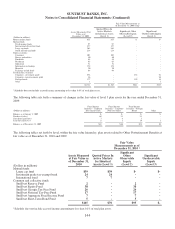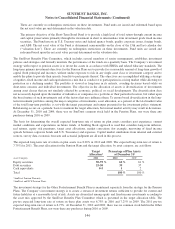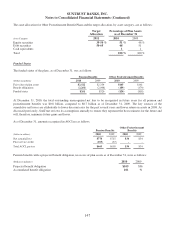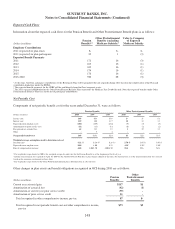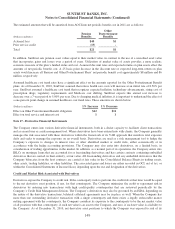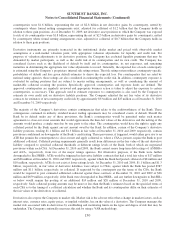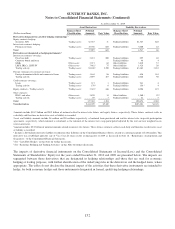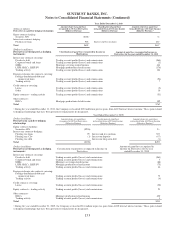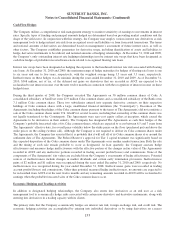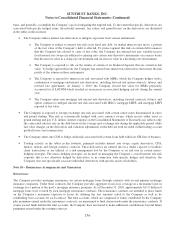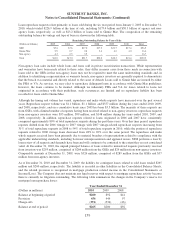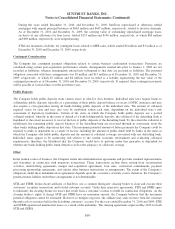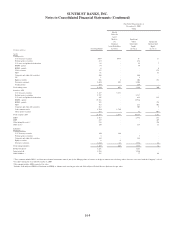SunTrust 2010 Annual Report Download - page 170
Download and view the complete annual report
Please find page 170 of the 2010 SunTrust annual report below. You can navigate through the pages in the report by either clicking on the pages listed below, or by using the keyword search tool below to find specific information within the annual report.
SUNTRUST BANKS, INC.
Notes to Consolidated Financial Statements (Continued)
Credit Derivatives
As part of its trading businesses, the Company enters into contracts that are, in form or substance, written guarantees:
specifically, CDS, swap participations, and TRS. The Company accounts for these contracts as derivative instruments and,
accordingly, records these contracts at fair value, with changes in fair value recorded in trading account profits/(losses) and
commissions.
The Company writes CDS, which are agreements under which the Company receives premium payments from its
counterparty for protection against an event of default of a reference asset. In the event of default under the CDS, the
Company would either net cash settle or make a cash payment to its counterparty and take delivery of the defaulted reference
asset, from which the Company may recover all, a portion, or none of the credit loss, depending on the performance of the
reference asset. Events of default, as defined in the CDS agreements, are generally triggered upon the failure to pay and
similar events related to the issuer(s) of the reference asset. As of December 31, 2010 and 2009, all written CDS contracts
reference single name corporate credits or corporate credit indices. When the Company has written CDS, it has generally
entered into offsetting CDS for the underlying reference asset, under which the Company paid a premium to its counterparty
for protection against an event of default on the reference asset. The counterparties to these purchased CDS are generally of
high creditworthiness and typically have ISDA master agreements in place that subject the CDS to master netting provisions,
thereby mitigating the risk of non-payment to the Company. As such, at December 31, 2010 and 2009, the Company did not
have any significant risk of making a non-recoverable payment on any written CDS. During 2010 and 2009, the only
instances of default on written CDS were driven by credit indices with constituent credit default. In all cases where the
Company made resulting cash payments to settle, the Company collected like amounts from the counterparties to the
offsetting purchased CDS. At December 31, 2010 and 2009, the written CDS had remaining terms ranging from two months
to five years and three months to five years, respectively. The maximum guarantees outstanding at December 31, 2010 and
2009, as measured by the gross notional amounts of written CDS, were $99 million and $130 million, respectively. At
December 31, 2010 and 2009, the gross notional amounts of purchased CDS contracts, which represent benefits to, rather
than obligations of, the Company, were $87 million and $185 million, respectively. The fair values of the written and
purchased CDS were de minimis as of both December 31, 2010 and 2009.
The Company writes risk participations, which are credit derivatives whereby the Company has guaranteed payment to a
dealer counterparty in the event that the counterparty experiences a loss on a derivative instrument, such as an interest rate
swap, due to a failure to pay by the counterparty’s customer (the “obligor”) on that derivative instrument. The Company
monitors its payment risk on its risk participations by monitoring the creditworthiness of the obligors, which is based on the
normal credit review process the Company would have performed had it entered into the derivative instruments directly with
the obligors. The obligors are all corporations or partnerships. However, the Company continues to monitor the
creditworthiness of its obligors and the likelihood of payment could change at any time due to unforeseen circumstances. To
date, no material losses have been incurred related to the Company’s written swap participations. At December 31, 2010 and
2009, the remaining terms on these risk participations generally ranged from one month to eight years and one month to nine
years, respectively, with a weighted average on the maximum estimated exposure of 3.1 years and 3.2 years, respectively.
The Company’s maximum estimated exposure to written swap participations, as measured by projecting a maximum value of
the guaranteed derivative instruments based on interest rate curve simulations and assuming 100% default by all obligors on
the maximum values, was $74 million and $83 million at December 31, 2010 and 2009, respectively. The fair values of the
written swap participations were de minimis at December 31, 2010 and 2009. As part of its trading activities, the Company
may enter into purchased swap participations, but such activity is not matched, as discussed herein related to CDS or TRS.
The Company has also entered into TRS contracts on loans. The Company’s TRS business consists of matched trades, such
that when the Company pays depreciation on one TRS, it receives the same depreciation on the matched TRS. As such, the
Company does not have any long or short exposure, other than credit risk of its counterparty, which is mitigated through
collateralization. The Company typically receives initial cash collateral from the counterparty upon entering into the TRS and
is entitled to additional collateral as the fair value of the underlying reference assets deteriorate. The Company temporarily
suspended this business and unwound its positions as of December 31, 2009 without incurring losses. Trading resumed
during 2010 and at December 31, 2010, there were $969 million of outstanding and offsetting TRS notional balances. The
fair values of the TRS derivative assets and liabilities were $34 million and $32 million at December 31, 2010, respectively,
and related collateral held at December 31, 2010 was $268 million.
154


